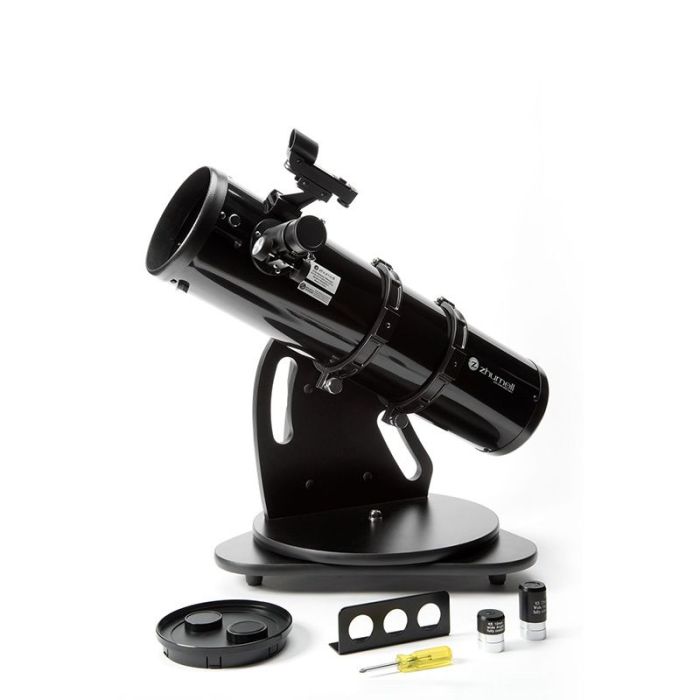
Offering clear, high-contrast views, refractor telescopes gather and focus light using lenses. Their designs are achromatic and apochromatic (APO); APOs lower chromatic aberration for best color correction. Because its optics stay aligned, refractors require less maintenance. Astronomers will find them a great choice since they shine in astrophotography, especially wide-field imaging, reducers, and motorized focusers. Let's hear more about Askar 160 APO Triplets Air-Spaced Refractor.
Highlighted Products
Featured Product 1
The Zhumell Z130 Portable Reflector is a portable, easy-to-use Dobsonian telescope with a parabolic primary mirror. It offers stunning views and smooth navigation for new stargazers or those looking to add to their collection.
Featured Product 2
A popular astrophotographer's telescope, the iOptron 12" low-thermal-expansion quartz mirrors, adjustable mounts, a fixed primary mirror, low-thermal-expansion truss supports, a dual-speed linear bearing focuser, and carbon fiber truss supports distinguish Photron Truss Tube RC OTA.
Featured Product 3
Connecting to a telescope via a StarSense dock, the Celestron StarSense Explorer LT 114AZ Essential Telescope Bundle is a smartphone-telescope solution for novices and amateurs. It provides exact object-centering directions and a smartphone camera for star pattern data
More About This Category
The Classic Cassegrain telescope is efficient and effective for astronomical studies. It uses a primary concave mirror and a secondary convex mirror to concentrate light. Amateur and professional astronomers now frequently use classic Cassegrain telescopes as a reflecting telescope type. Named for the French sculptor and amateur astronomer Laurent Cassegrain, who developed this optical design, these telescopes are renowned for their unusual mix of mirrors that enable a small yet robust construction.
Apertura developed the 8-inch Classical Cassegrain, a visual observing tool. It combines current developments in quality of life with the optical design of catadioptric telescopes. With standard eyepiece focal lengths, the scope offers remarkable visual perspectives rich in depth and contrast, enabling a close-up view of big and little objects. This modest scale allows one limited scope to examine a great range of fantastic stuff.
Modern, high-performance visual viewing powerhouse the Apertura 6" Classical Cassegrain Telescope combines contemporary elements with the ageless design of the traditional Cassegrain. The telescope has been tuned to maximize the 6" aperture, so presenting breathtaking views of the night sky with more fine detail and contrast than other products. Its 1800 mm focal length lets one examine vast and small objects, including the tiny NGC6910 open cluster and the giant Orion nebula. Comprising primary, secondary, and optical tube baffles, the telescope also boasts a sophisticated baffle system that maximizes contrast and optimizes precise optics.
Essential Information About Classic Cassegrain Telescopes
- Optical Design: To get the right focal length and guarantee clean images, a classic Cassegrain telescope uses high-quality glass primary and secondary mirrors covered in reflective materials, including aluminum or improved aluminum. A convex secondary mirror fixes optical aberrations. The telescope's basic optical design consists of light entering and being reflected by a big concave primary mirror, producing a long focal length in a short optical tube.
- Focal Length and Focal Ratio: Classic Cassegrain telescopes usually run from f/10 to f/15 and feature long focal lengths and high focal ratios. They are perfect for high-resolution planetary and lunar studies when magnification and detail are critical. Their lengthy focal length makes them ideal for viewing double stars and other objects benefiting from high magnification.
Comparing other Telescopes and Classic Cassegrain
- Compact and light, the Classic Cassegrain telescope is easy to mount and handle. It is beginner-friendly, even if refractors are simple and reliant on constant collimation for image quality. Perfect for high-magnitude gazing but less flexible for wide-field astrophotography, its sizeable focal length and focal solid ratios
- Refractors are less suited for high-magnitude planetary research even if they offer shorter focal ratios and more wide-ranging fields of view. Newtonian reflectors have modest focal ratios that balance wide-field views and magnification, even if they might need more correctors.
- Maintenance for classical cascades involves occasional cleaning and collimation, while refractors require minimal cleaning and occasional cleaning of the objective lens, and Newtonian reflectors require frequent cleaning and collimation.


